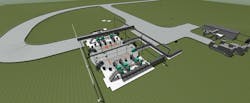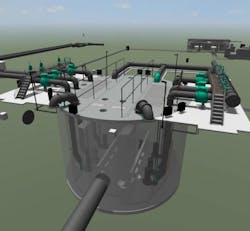Lift Station in the Lead
About the author: Daniel E. Dow, P.E., is infrastructure manager for Lockwood, Andrews & Newnam Inc. Dow can be reached at [email protected].
The LaSalle Lift Station will provide a net savings of $17 million over the next 50 years.
The Waco (Texas) Metropolitan Area Regional Sewer System (WMARSS) owns, operates and maintains five major lift stations and their associated gravity interceptors within the collection system. Wastewater generated by portions of the cities of Waco, Lacy Lakeview, and Bellmead, Texas, is conveyed via interceptors upstream of the existing LaSalle Lift Station. From there, the wastewater is combined and pumped by the LaSalle Lift Station to a transfer lift station, then pumped from that facility to Waco’s central wastewater treatment plant.
The LaSalle Lift Station, the second largest lift station in the Waco metropolitan area, conveys peak flows of approximately 30 million gal per day (mgd) to the central plant. Built in the 1970s, the lift station wet well and flow control structures are nearing the end of their 50-year design life. In addition, over the past few years, the stability of the soil in the region has been a significant concern. Construction of a nearby utility created a sinkhole in close proximity to the lift station. This soil instability, coupled with the elevated water table due to the proximity of the Brazos River, creates the possibility of soil stability failure around the lift station.
The 83-mgd transfer lift station, designed and constructed in the early 1980s, is the largest in the collection system. A 2013 assessment report revealed that this lift station has been experiencing electrical and structural problems for some time. Additionally, there also are concerns with the capacity of the transfer lift station and the structural integrity of the associated 54-in. force main.
With both lift stations in need of major rehabilitation, the city of Waco responded aggressively. In March 2015, the city hired Lockwood, Andrews & Newnam Inc. (LAN), a planning, engineering and program management firm, to evaluate potential alternatives and recommend solutions to replace the LaSalle Lift Station, upgrade the existing transfer lift station, and provide a reliable force main from the transfer lift station to the central plant. Other members of the project team included Carollo Engineers Inc. and The Wallace Group Inc.
Alternative Analysis
The project team performed an exhaustive analysis using its knowledge of the collection system and prior assessment reports. The analysis was done with the goal of providing a total solution for the collection system in the area, and it took into account a number of factors, including permitting issues, construction constraints, capital costs, operations and maintenance lifecycle costs, and Waco’s capital improvement plan (CIP).
Based on the analysis, the project team provided the city with four alternatives. After reviewing the alternatives, the team recommended the system that included gravity with a siphon to a new 140-mgd transfer lift station with a force main to the wastewater treatment plant as the solution for the issues surrounding the two lift stations. This option had a total cost of $46.4 million.
This solution eliminated the use of a lift station through the use of an inverted siphon to cross the Brazos River, thereby significantly reducing the operational and maintenance costs, as well as eliminating the electrical costs that would be associated with a replacement of the LaSalle Lift Station.
“Instead of replacing the LaSalle Lift Station, we realized that building a new transfer lift station was a better solution both from a long-term operations and costs perspective,” said Drew Hardin, P.E., vice president for LAN. “Also, the existing transfer lift station, along with its force main, were on the city’s CIP list for millions of dollars of rehabilitation. So, this solution addresses all three projects on the CIP list—replacement of the LaSalle Lift Station, rehabilitation of the transfer lift station and [rehabilitation of] its force main to the central plant—in a cost-effective manner.”
This option provides additional benefits by addressing some issues at the transfer lift station, namely adding a redundant force main to the largest lift station in the WMARSS collection system and upgrading the lift station to include advanced controls and the associated energy savings. The dual force main allows the transfer lift station to accept the increasing flows from the system while maintaining a lower head on the pumps, reducing the required horsepower, versus maintaining the current single force main.
In addition, the savings for this option versus the next closest option were more than $5.5 million in capital costs alone. The net present value analysis, including operation and maintenance costs, provides a savings in excess of $17 million over the next 50 years.
Project Challenges
After selecting this option, the city contracted the LAN project team to develop detailed engineering designs for the new gravity interceptor, siphon, transfer lift station and force main. To incorporate these improvements, the project team considered a number of issues. Chief among them was the proximity to the Brazos River along portions of the project route.
“The gravity interceptor is about 25 to 35 ft deep and is located next to the river,” Hardin said. “When the water table fluctuates, it can create quicksand conditions, causing the soil to migrate from the pipe. In addition to continuously dewatering during installation, crews will also be lining the trench with geo-textile material before putting in the bedding and backfill to prevent this migration.”
Soil conditions were another challenge. Site analysis showed the presence of blue shale at a depth of 40 ft in the project area. Blue shale affects deep excavation and boring by presenting a barrier with significantly more hardness than the Brazos Alluvium that is present over most of the project. With the new transfer lift station planned to be constructed at a depth of approximately 45 ft, the project team recommended using caisson construction to prevent groundwater intrusion into this structure.
Due to Texas Commission on Environmental Quality (TCEQ) regulations, the project required the use of corrosion-resistant materials for the force main from the transfer lift station to the central plant. Consequently, the pipe materials considered for the force main were limited based on the availability of the required pipe diameter and corrosion-resistant pipe material and liner. After significant research and discussion with WMARSS staff, the project team decided to use fiberglass pipe for the force main.
“We narrowed the options down to PVC, HDPE or fiberglass pipe,” Hardin said. “There were very few PVC manufacturers in the area that could meet the specifications we needed, which were on the extreme upper end for a PVC pipe. Also, TCEQ required a 150-psi requirement, and HDPE pipes could not reach that pressure threshold. So, we were down to one option. To add to that challenge, there were only two fiberglass manufacturers. One of them couldn’t provide restraint joints, which were a necessity for this project. We had to go through a lot of options to meet the material requirements for the force main.”
Despite these challenges, the city of Waco is on its way to implementing the new lift station, which will meet the region’s wastewater demands for the next 30 years. Final design will be completed in March 2017 and the project will be bid in May 2017. The project is expected to be complete in the spring of 2019.

